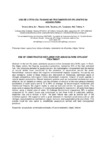Por favor, use este identificador para citar o enlazar este ítem:
http://www.alice.cnptia.embrapa.br/alice/handle/doc/917976| Título: | Uso de leitos cultivados no tratamento de efluentes da aquicultura. |
| Autor: | SILVEIRA-SILVA, M.  ROSTON, D. M.   QUEIROZ, J. F. de   LOSEKANN, M. E.   ALBINO, T.   |
| Afiliación: | MARIANA SILVEIRA GUERRA MOURA E SIL, CNPMA; DENIS MIGUEL ROSTON, FEAGRI-UNICAMP; JULIO FERRAZ DE QUEIROZ, CNPMA; MARCOS ELISEU LOSEKANN, CNPMA; THAMYRES ALBINO, FEAGRI-UNICAMP. |
| Año: | 2011 |
| Referencia: | In: SIMPÓSIO INTERNACIONAL SOBRE GERENCIAMENTO DE RESÍDUOS AGROPECUÁRIOS E AGROINDUSTRIAIS, 2., 2011, Foz do Iguaçu. Anais... Foz do Iguaçu: Sociedade Brasileira dos Especialistas em Resíduos das Produções Agropecuária e Agroindustrial, 2011. 1 CD ROM. |
| Descripción: | In the last fifty years, worldwide aquaculture has increased about 8.8% /year. In Brazil, the tilapia culture, the flagship aquaculture production, represents 39% of the total cultivated fish. The increasing demand for aquatic protein, the demographic increasement and the decline of natural stocks have contributed to the promotion of aquaculture around the world. Nevertheless, concerns about the negative environmental impacts caused by this activity are also increasing. Some of these impacts are: destruction of mangroves, significant inputs of nitrogen, phosphorus and organic matter downstream nurseries, invasion of exotic species in natural aquatic ecosystems. Natural treatment systems such as constructed wetlands are costeffective, do not depend on energy, and the efficiency of removal of the main physico-chemical parameters of water quality are at 70 to 90% on average. By bacteriological metabolism and mechanical filtration, the organic matter is used as food and nutrient for aquatic plants. This study aims to assess the efficiency of constructed wetlands for treatment of effluents from tilapia culture, using a closed cycle of water. At Embrapa Environment (Jaguariúna, SP), a system composed by 54 plastic boxes was constructed to test three kinds of substrates: pebbles, expanded clay and a mixture of both. The plant Vetiver was used as another part of the treatment system. We expect to verify a great reduction in important parameters such as total nitrogen, total phosphorus, biochemical oxygen demand, total suspended solids and others. This system could be very useful at smallholder aquaculture worried with best management practices. |
| Thesagro: | Tilapia Vetiver Aquicultura |
| NAL Thesaurus: | Aquaculture Constructed wetlands Effluents |
| Palabras clave: | Tratamento de efluentes Leitos cultivados |
| Tipo de Material: | Artigo em anais e proceedings |
| Acceso: | openAccess |
| Aparece en las colecciones: | Artigo em anais de congresso (CNPMA)  |
Ficheros en este ítem:
| Fichero | Descripción | Tamaño | Formato | |
|---|---|---|---|---|
| 2011AA55.pdf | 32,77 kB | Adobe PDF |  Visualizar/Abrir |









